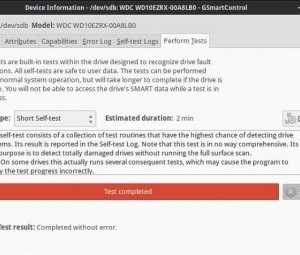

- #Check hard disk health linux command install
- #Check hard disk health linux command portable
- #Check hard disk health linux command mac
- #Check hard disk health linux command windows
You'll get all the arguments and parameters you can mix and match to customize the tests as extensive and comprehensive as possible. If you want to explore all the possible options you can use with the smartctl command, you can pull it up by using the following: $smartctl -help You'll get the following short output, and rather than stats, you'll see if the test passed or failed. If you want to inspect the overall health of your data storage device, type and run the following: $sudo smartctl -d ata -H /dev/sda Through this long test, you'll get everything included in the short test along with much more. Through this short test, you'll test the electrical and mechanical properties along with read/verify.Īlso, you can run a long test, using the following command: $ sudo smartctl -t long -a /dev/sda Now you can launch a short test, using the following command: $ sudo smartctl -t short -a /dev/sda Once the service has been started, get the information of your hard drive through the following command: $ sudo smartctrl -i /dev/sda Type this command to check the status: $ systemctl status smartd Since you need the service running, you need to check the status of the service before running any tests. Once done, you'll need to start the service through the following command: $ systemctl start smartd
#Check hard disk health linux command install
In your terminal, type the following: $ sudo apt-get install smartmontools -y Via the terminal, you'll need to start by installing the SmartCtl package. Checking HDD / SSD Health via the terminal If there are multiple storage devices, you can go back to the previous window and select the other device to test it.Ģ.

In the window that opens up, you’ll be able to see the status of your data storage device. Open the options menu, it's next to the minimize button.Then, Select the HDD/SSD you want to test. Once the application opens up, it will list the data storage devices in your computer. When the text box for search pops up, type "Disks", now click on the icon and launch the application. You can either start by pressing the "window" key or by clicking on "Activities" in the upper left corner of the screen. You can start by opening up the " Disks" Application. Here, you can perform the tests without much knowledge of terminal commands. Checking HDD / SSD Health via the interface HDD / SSD Health checks can be performed via the GUI solution (GNOME Disks) as well as through a command line tool.ġ. In this context, we shall look into how you can check the health of your HDD/SSD in Ubuntu 20.04.ĭifferent ways to check your HDD / SSD Health in Ubuntu ? Here at LinuxAPT, as part of our Server Management Services, we regularly help our Customers to perform related Linux system performance queries. The main differences between these two boils down to the price and the IO speeds. The two main types are known as HDD aka Hard Disk Drive and SSD aka Solid-State Drive. A data storage device is a core-component of any computer. Though laptops and desktops are very resilient, you should keep checking the health of the components to ensure the longevity.
#Check hard disk health linux command mac
It's also available for Linux and Mac operating systems, as well as included in a couple of LiveCD/LiveUSB programs.If you want to ensure that your computer performs optimally, it is crucial that your HDD / SSD performs well.
#Check hard disk health linux command windows
The latest version works with Windows 11, 10, 8, 7, and Vista, but there's an outdated edition you can get for older Windows versions.
#Check hard disk health linux command portable
This program can be downloaded for Windows as a portable program or as a regular program with a normal installer. GSmartControl runs three self-tests to find drive faults: Short Self-test takes around 2 minutes to complete and is used to detect a completely damaged hard drive, Extended Self-test takes 70 minutes to finish and examines the entire surface of a hard drive to find faults, and Conveyance Self-test is a 5-minute test that's supposed to find damages that occurred during the transporting of a drive. View and save SMART attribute values like the power cycle count, multi-zone error rate, calibration retry count, and many others. GSmartControl can run various hard drive tests with detailed results and give an overall health assessment of a drive. When exporting information, it includes everything, not just a specific result you want to save Doesn't support every USB and RAID device


 0 kommentar(er)
0 kommentar(er)
